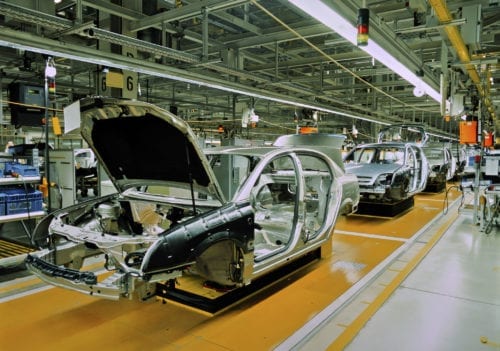unfinished automobiles in a car plant

How much CO2 is embedded in a product?
Toward an Emissions Calculation Framework for the Minerals Industry
Imagine driving your brand-new electric vehicle along Main Street on a weekday evening. Sleek and silent, you are the envy of the entire town. You know that the carbon dioxide directly emitted from the engine is nil: that was the whole point of buying the thing, wasn’t it? Going a little further—as you are an environmentally conscious owner—you didn’t find it difficult to figure out, and abate, the climate impact of the electricity you used to charge the car: your local utility offers a green tariff so that you can buy low-carbon electricity.
At this point, you might think that your job of reducing the carbon footprint of your car is pretty much complete. But have you ever thought about the CO2 that was emitted in the production of the car? How far were the materials and components transported? Was the lithium in the batteries extracted in a high-altitude Chilean desert or in a remote part of China? Was the copper in the wires mined in Arizona or in Africa? Was the iron ore for the steel extracted in Australia and then processed in China, or was the steel made from recycled scrap metal?
It’s very likely that you can’t answer any of these questions; the embedded carbon content of any product is largely unknown to the final consumer. Very few consumers are aware of the carbon that has been generated in the production and delivery of products and, as a consequence, virtually nobody takes action to abate these emissions. This is a problem because only 9 percent of carbon emissions come from passenger fuels and 25 percent come from the generation of electricity, while 40 percent of emissions come from the production and delivery of commodities in industrial value chains (31.5 percent from the industrial activities themselves, and 8.5 percent from freight and transport).
What’s the direct consequence for your electric vehicle? The truth is that the accumulated carbon footprint of materials in a newly bought gasoline-fueled car is the same order of magnitude as the footprint of its lifetime fuel consumption—so by buying an electric vehicle and securing green electricity, you are only part of the way through abating your car’s total carbon footprint.
What can we do to change this? Because what is out of sight is often out of mind, the first step is to calculate and communicate the CO2 emissions that are embedded in produced goods. Until people know the CO2 footprint of the products they’re using, it will be impossible for them to demand lower-carbon goods.
On the bright side, something has already begun moving: because end-customers are beginning to demand “cleaner” products, companies are starting to develop joint strategies to reduce carbon emissions in coordination with their supply chain partners. For instance, Apple signed an agreement with Alcoa and Rio Tinto to reduce the carbon content of the aluminum in its products. BMW teamed up with Codelco to reduce the environmental footprint of copper, a key input for its electric vehicle fleet. And there is an expectation that green procurement guidelines from the Organisation for Economic Co-operation and Development, as well as from the European Union and US-based initiatives like the Buy Clean Alliance and the Buy Clean California Act will reward tender proposals that have lower emissions along their supply chains.
At the same time, another force is driving materials producers to lower their carbon impact: shareholders, institutional investors, and project finance lenders are increasingly tracking carbon emissions as they scrutinize climate risks in their portfolios. In the United States, climate change in 2018 again topped the list of environmental, social, and sustainability resolutions taken. In the United Kingdom, the “Aiming for A” coalition submitted climate change resolutions at the annual meetings of Anglo American, Rio Tinto and Glencore to increase transparency of how the companies deal with climate change risks. All of the resolutions successfully passed with more than 96 percent of the votes.
Is Apples-to-Apples CO2 Comparison Possible in the Complex Minerals Sector?
While climate disclosure in the minerals sector is increasing, it remains a challenge to compare CO2 emissions across companies and supply chains. This is mainly due to two factors: the sheer complexity of the sector, and the lack of a universal calculation framework.
Broadly speaking, minerals can be metals or nonmetals, and metals can be ferrous or nonferrous: this leads to a natural division of the sector into three industries. However, there is a wide disparity among these three, as well as among materials within the same industry, in terms of volumes produced, energy utilized, and CO2 emitted: some industrial practices are more energy intensive than others; some processes are orders of magnitude larger, and/or more intensive, than others. To complicate things further, the correlation between energy use and emissions is sometimes an oversimplification because of significant non-energy process emissions, such as those in steel and cement. Because of this imbalance, it is not easy to compare intensity and absolute emissions across the board. At this time, there is no methodology providing specific guidance for carbon accounting in the minerals sector, leading to uncertainty for those seeking to use these metrics for their own sustainability strategies; product carbon footprints; science-based targets; environmental, social, and governance indexes; or other purposes.
Over the past decade, there has been a proliferation of carbon accounting tools and methodologies that provide a roadmap for the minerals sector. These methods have been mostly developed on a voluntary basis and either financed by the reporting parties themselves, or developed from the ground up by nonprofit efforts in specific sectors. For example, the Greenhouse Gas Protocol offers a widely accepted overarching framework that distinguishes between a company’s direct fuel emissions (Scope 1), its emissions from purchased electricity (Scope 2), and the total emissions along its value chain from the manufacture and delivery of its products to their eventual disposal or recycling (Scope 3). However, the Greenhouse Gas Protocol’s high-level accounting practices make effective parameter specification difficult and allow room for interpretation that can impede comparisons. This has led to a set of sector-specific carbon accounting initiatives that are not always connected across value chains.
The situation is further complicated by various reporting platforms, (e.g., the Carbon Disclosure Project [CDP], the Task Force on Climate-related Financial Disclosures [TCFD], the Principles for Responsible Investment [PRI], and the Global Reporting Initiative [GRI]), which have their own accounting principles that may or may not be aligned with the other methods. This complexity has hampered the consolidation of a standard framework for reporting carbon emissions. Such a framework might one day become commonly adopted, for example, via inclusion in International Accounting Standards Board/Financial Accounting Standards Board standards and, eventually, in an eco-label clearly stating a product’s carbon footprint.
Toward a Calculation Framework for Minerals
The MIT Sustainable Supply Chains initiative, Columbia Center for Sustainable Investment, and Rocky Mountain Institute’s Materials initiative have formed a working group to engage minerals producers, end users, investors, and other stakeholders interested in carbon accounting. The group will work collaboratively to develop a joint carbon accounting framework for the minerals industry and its supply chain partners with the goal of it becoming certified as “Built on the GHG Protocol.”
This group is going to develop sector-specific guidance for metals and minerals, following the template of successful collaborative carbon accounting initiatives for freight transportation (the Global Logistics Emissions Council [GLEC] Framework) and information and communication technology products (ICT Sector Guidance). The project will also build on the current work of Resolve, which is developing a Climate Smart Mining Emissions Widget that aims to bring alignment and consistency across mining-related standards and initiatives on climate reporting and raise awareness of the need to develop a science-based target methodology for the sector.
The group will enable a collaborative consortium made up of academia, industry, and other stakeholders in order to undertake the effort. After a mapping exercise of existing methodologies, current company practices, and other relevant inputs, the group will identify the best practices to build into a comprehensive framework for carbon reporting that works for all players along minerals value chains. The output will provide guidance on calculating absolute emissions (Scopes 1, 2, and 3) from companies along the value chain. It will also provide a framework for calculating emissions intensities, that is, the carbon footprints of materials as they are sold and continue their journeys along the value chain. This will enable standardized reporting to CDP, TCFD, GRI, and others, as well as reliable carbon footprint values that give a true sense of the embodied emissions of metals and minerals used in end products such as renewable energy systems, buildings, electronics, and your beloved electric car.
The emissions calculations framework for the minerals industry is the first step in the journey toward carbon transparency that will be needed for consumers and investors to understand and drive the decarbonization of industrial sectors. This is a necessary enabler for anything that comes next. In the words of the Little Prince, “as for the future, your task is not to foresee it, but to enable it.” The vision for a low-carbon industry is out there; it is now time to focus on the mechanisms that can make it happen.


